Canon R10 vs SL3
The Canon EOS R10 and the Canon EOS Rebel SL3 (labelled Canon 250D in some countries) are two digital cameras that were officially introduced, respectively, in May 2022 and April 2019. The R10 is a mirrorless interchangeable lens camera, while the SL3 is a DSLR. Both cameras are equipped with an APS-C sensor. Both cameras offer a resolution of 24 megapixels.
Below is an overview of the main specs of the two cameras as a starting point for the comparison.

Check R10 price at
amazon.com

Check SL3 price at
amazon.com
Going beyond this snapshot of core features and characteristics, what are the differences between the Canon EOS R10 and the Canon EOS Rebel SL3? Which one should you buy? Read on to find out how these two cameras compare with respect to their body size, their imaging sensors, their shooting features, their input-output connections, and their reception by expert reviewers.
Body comparison
The side-by-side display below illustrates the physical size and weight of the Canon R10 and the Canon SL3. The two cameras are presented according to their relative size. Three consecutive perspectives from the front, the top, and the back are available. All width, height and depth measures are rounded to the nearest millimeter.
The SL3 can be obtained in two different colors (black, white), while the R10 is only available in black.
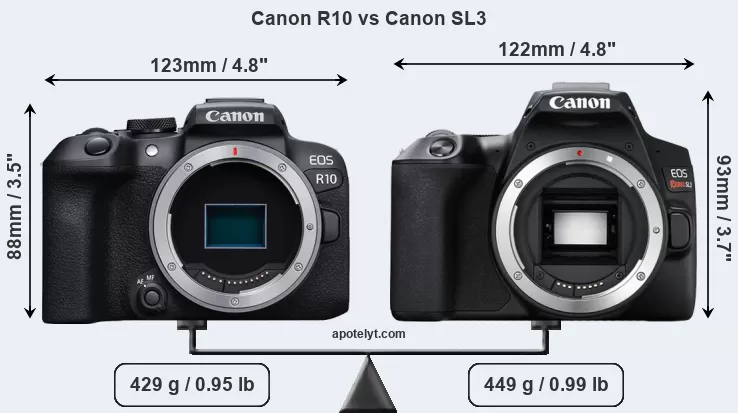
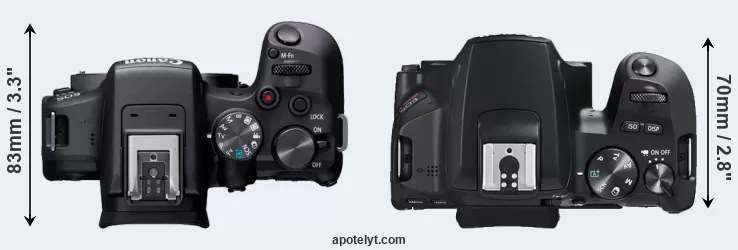
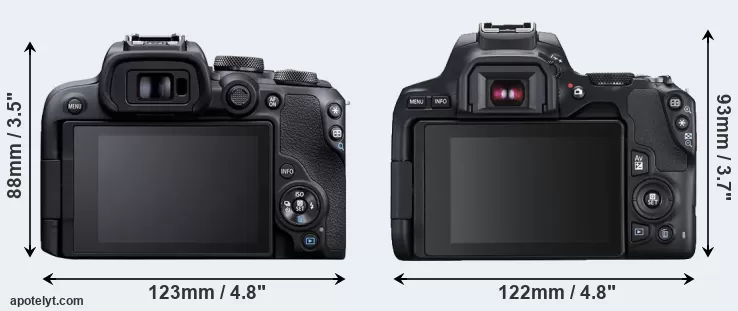
If the front view area (width x height) of the cameras is taken as an aggregate measure of their size, the Canon SL3 is somewhat larger (5 percent) than the Canon R10. Moreover, the SL3 is markedly heavier (5 percent) than the R10. In this context, it is worth noting that neither the R10 nor the SL3 are weather-sealed.
The above size and weight comparisons are to some extent incomplete since they do not consider the interchangeable lenses that both of these cameras require. Hence, you might want to study and compare the specifications of available lenses in order to get the full picture of the size and weight of the two camera systems.
The power pack in the R10 can be charged via the USB port, so that it is not always necessary to take the battery charger along when travelling.
The following table provides a synthesis of the main physical specifications of the two cameras and other similar ones. If you would like to visualize and compare a different camera combination, you can navigate to the CAM-parator app and make your selection from a broad list of cameras there.

| # | Camera Model |
Camera Width |
Camera Height |
Camera Depth |
Camera Weight |
Battery Life |
Weather Sealing |
Camera Launch |
Launch Price (USD) |
Street Price |
|
|---|---|---|---|---|---|---|---|---|---|---|---|
| 1. | Canon R10 | 123 mm | 88 mm | 83 mm | 429 g | 450 | n | May 2022 | 979 | amazon.com | |
| 2. | Canon SL3 | 122 mm | 93 mm | 70 mm | 449 g | 1070 | n | Apr 2019 | 599 | amazon.com | |
| 3. | Canon R50 | 116 mm | 86 mm | 69 mm | 375 g | 230 | n | Feb 2023 | 679 | amazon.com | |
| 4. | Canon R100 | 116 mm | 86 mm | 69 mm | 356 g | 400 | n | May 2023 | 479 | amazon.com | |
| 5. | Canon T8i | 131 mm | 103 mm | 76 mm | 515 g | 800 | n | Feb 2020 | 749 | ebay.com | |
| 6. | Canon M50 Mark II | 116 mm | 88 mm | 59 mm | 387 g | 305 | n | Oct 2020 | 599 | ebay.com | |
| 7. | Canon M6 Mark II | 120 mm | 70 mm | 49 mm | 408 g | 305 | n | Aug 2019 | 849 | ebay.com | |
| 8. | Canon M50 | 116 mm | 88 mm | 59 mm | 390 g | 235 | n | Feb 2018 | 779 | ebay.com | |
| 9. | Canon T7 | 129 mm | 101 mm | 78 mm | 475 g | 500 | n | Feb 2018 | 449 | amazon.com | |
| 10. | Canon 77D | 131 mm | 100 mm | 76 mm | 540 g | 600 | n | Feb 2017 | 899 | ebay.com | |
| 11. | Canon SL2 | 122 mm | 93 mm | 70 mm | 453 g | 650 | n | Jun 2017 | 549 | ebay.com | |
| 12. | Canon M5 | 116 mm | 89 mm | 61 mm | 427 g | 295 | n | Sep 2016 | 979 | ebay.com | |
| Note: Measurements and pricing do not include easily detachable parts, such as add-on or interchangeable lenses or optional viewfinders. | |||||||||||
Any camera decision will obviously take relative prices into account. The manufacturer’s suggested retail prices give an idea on the placement of the camera in the maker’s lineup and the broader market. The SL3 was launched at a markedly lower price (by 39 percent) than the R10, which puts it into a different market segment. Normally, street prices remain initially close to the MSRP, but after a couple of months, the first discounts appear. Later in the product cycle and, in particular, when the replacement model is about to appear, further discounting and stock clearance sales often push the camera price considerably down. Then, after the new model is out, very good deals can frequently be found on the pre-owned market.
Sensor comparison
The imaging sensor is at the core of digital cameras and its size is one of the main determining factors of image quality. A large sensor will generally have larger individual pixels that offer better low-light sensitivity, provide wider dynamic range, and have richer color-depth than smaller pixels in a sensor of the same technological generation. Moreover, a large sensor camera will give the photographer more control over depth-of-field in the image and, thus, the ability to better isolate a subject from the background. On the downside, larger sensors tend to be more expensive and lead to bigger and heavier cameras and lenses.
Both cameras under consideration feature an APS-C sensor, but their sensors differ slightly in size. The sensor area in the SL3 is 1 percent bigger. They nevertheless have the same format factor of 1.6. Both cameras have a native aspect ratio (sensor width to sensor height) of 3:2.
In terms of chip-set technology, the R10 uses a more advanced image processing engine (DIGIC X) than the SL3 (DIGIC 8), with benefits for noise reduction, color accuracy, and processing speed.
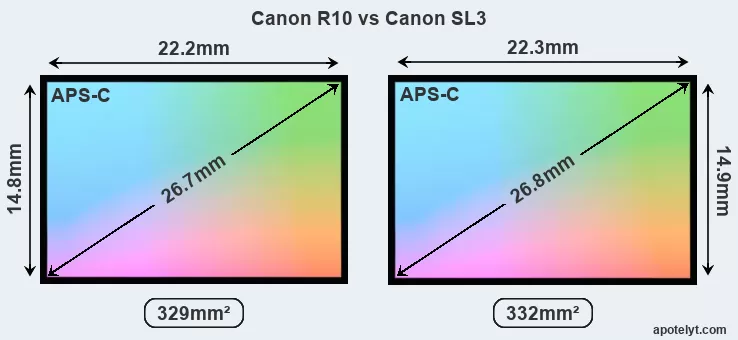
Even though the SL3 has a slightly larger sensor, both cameras offer the same resolution of 24 megapixels. This implies that the SL3 has a lower pixel density and marginally larger individual pixels (with a pixel pitch of 3.72μm versus 3.70μm for the R10), which gives it a potential advantage in terms of light gathering capacity. It should, however, be noted that the R10 is much more recent (by 3 years and 1 month) than the SL3, and its sensor will have benefitted from technological advances during this time that at least partly compensate for the smaller pixel size.
The Canon EOS R10 has a native sensitivity range from ISO 100 to ISO 32000, which can be extended to ISO 100-51200. The corresponding ISO settings for the Canon EOS Rebel SL3 are ISO 100 to ISO 25600, with the possibility to increase the ISO range to 100-51200.
Technology-wise, both cameras are equipped with CMOS (Complementary Metal–Oxide–Semiconductor) sensors. Both cameras use a Bayer filter for capturing RGB colors on a square grid of photosensors. This arrangement is found in most digital cameras.
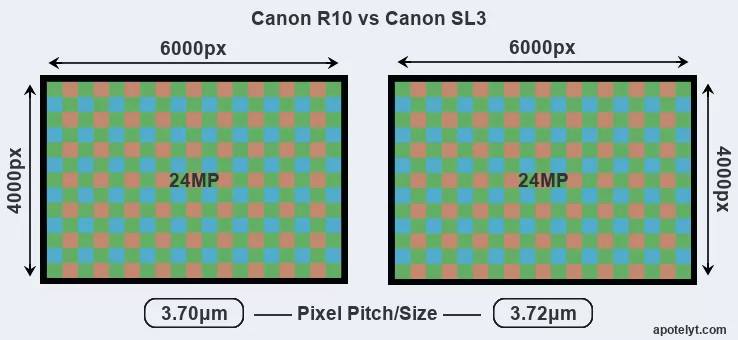
Consistent information on actual sensor performance is available from DXO Mark for many cameras. This service assesses and scores the color depth ("DXO Portrait"), dynamic range ("DXO Landscape"), and low-light sensitivity ("DXO Sports") of camera sensors, and also publishes an overall camera score. The table below summarizes the physical sensor characteristics and sensor quality findings and compares them across a set of similar cameras.

| # | Camera Model |
Sensor Class |
Resolution (MP) |
Horiz. Pixels |
Vert. Pixels |
Video Format |
DXO Portrait |
DXO Landscape |
DXO Sports |
DXO Overall |
|
|---|---|---|---|---|---|---|---|---|---|---|---|
| 1. | Canon R10 | APS-C | 24.0 | 6000 | 4000 | 4k/60p | 24.1 | 13.8 | 2085 | 84 | |
| 2. | Canon SL3 | APS-C | 24.0 | 6000 | 4000 | 4K/25p | 23.9 | 13.4 | 1791 | 82 | |
| 3. | Canon R50 | APS-C | 24.0 | 6000 | 4000 | 4K/30p | 24.1 | 13.9 | 2168 | 84 | |
| 4. | Canon R100 | APS-C | 24.0 | 6000 | 4000 | 4k/24p | 24.1 | 13.9 | 2197 | 84 | |
| 5. | Canon T8i | APS-C | 24.0 | 6000 | 4000 | 4K/24p | 24.0 | 13.5 | 1873 | 83 | |
| 6. | Canon M50 Mark II | APS-C | 24.0 | 6000 | 4000 | 4K/24p | 24.0 | 13.6 | 1939 | 83 | |
| 7. | Canon M6 Mark II | APS-C | 32.3 | 6960 | 4640 | 4K/30p | 24.0 | 13.5 | 1848 | 83 | |
| 8. | Canon M50 | APS-C | 24.0 | 6000 | 4000 | 4K/24p | 23.8 | 13.3 | 1684 | 81 | |
| 9. | Canon T7 | APS-C | 24.0 | 6000 | 4000 | 1080/30p | 23.8 | 13.3 | 1684 | 81 | |
| 10. | Canon 77D | APS-C | 24.0 | 6000 | 4000 | 1080/60p | 23.6 | 13.3 | 971 | 78 | |
| 11. | Canon SL2 | APS-C | 24.0 | 6000 | 4000 | 1080/60p | 23.6 | 13.4 | 1041 | 79 | |
| 12. | Canon M5 | APS-C | 24.0 | 6000 | 4000 | 1080/60p | 23.4 | 12.4 | 1262 | 77 | |
| Note: DXO values in italics represent estimates based on sensor size and age. | |||||||||||
Many modern cameras cannot only take still pictures, but also record videos. Both cameras under consideration are equipped with sensors that have a sufficiently high read-out speed for moving images, but the R10 provides a higher frame rate than the SL3. It can shoot video footage at 4k/60p, while the SL3 is limited to 4K/25p.
Feature comparison
Apart from body and sensor, cameras can and do differ across a variety of features. For example, the R10 has an electronic viewfinder (2360k dots), while the SL3 has an optical one. Both systems have their advantages, with the electronic viewfinder making it possible to project supplementary shooting information into the framing view, whereas the optical viewfinder offers lag-free viewing and a very clear framing image. The viewfinder in the R10 offers a wider field of view (100%) than the one in the SL3 (95%), so that a larger proportion of the captured image is visible in the finder. In addition, the viewfinder of the R10 has a higher magnification (0.58x vs 0.54x), so that the size of the image transmitted appears closer to the size seen with the naked human eye. The table below summarizes some of the other core capabilities of the Canon R10 and Canon SL3 in connection with corresponding information for a sample of similar cameras.

| # | Camera Model |
Viewfinder (Type or 000 dots) |
Control Panel (yes/no) |
LCD Specifications (inch/000 dots) |
LCD Attach- ment |
Touch Screen (yes/no) |
Max Shutter Speed * |
Max Shutter Flaps * |
Built-in Flash (yes/no) |
Built-in Image Stab |
|
|---|---|---|---|---|---|---|---|---|---|---|---|
| 1. | Canon R10 | 2360 | n | 3.0 / 1040 | swivel | Y | 1/8000s | 15.0/s | Y | n | |
| 2. | Canon SL3 | optical | n | 3.0 / 1040 | swivel | Y | 1/4000s | 5.0/s | Y | n | |
| 3. | Canon R50 | 2360 | n | 3.0 / 1620 | swivel | Y | 1/4000s | 12.0/s | Y | n | |
| 4. | Canon R100 | 2360 | n | 3.0 / 1040 | fixed | n | 1/4000s | 6.5/s | Y | n | |
| 5. | Canon T8i | optical | n | 3.0 / 1040 | swivel | Y | 1/4000s | 7.5/s | Y | n | |
| 6. | Canon M50 Mark II | 2360 | n | 3.0 / 1040 | swivel | Y | 1/4000s | 10.0/s | Y | n | |
| 7. | Canon M6 Mark II | optional | n | 3.0 / 1040 | tilting | Y | 1/4000s | 14.0/s | Y | n | |
| 8. | Canon M50 | 2360 | n | 3.0 / 1040 | swivel | Y | 1/4000s | 10.0/s | Y | n | |
| 9. | Canon T7 | optical | n | 3.0 / 920 | fixed | n | 1/4000s | 3.0/s | Y | n | |
| 10. | Canon 77D | optical | Y | 3.0 / 1040 | swivel | Y | 1/4000s | 6.0/s | Y | n | |
| 11. | Canon SL2 | optical | n | 3.0 / 1040 | swivel | Y | 1/4000s | 5.0/s | Y | n | |
| 12. | Canon M5 | 2360 | n | 3.2 / 1620 | tilting | Y | 1/4000s | 9.0/s | Y | n | |
| Note: *) Information refers to the mechanical shutter, unless the camera only has an electronic one. | |||||||||||
The reported shutter speed information refers to the use of the mechanical shutter. Yet, some cameras only have an electronic shutter, while others have an electronic shutter in addition to a mechanical one. In fact, the R10 is one of those camera that have an additional electronic shutter, which makes completely silent shooting possible. However, this mode is less suitable for photographing moving objects (risk of rolling shutter) or shooting under artificial light sources (risk of flickering).
The Canon R10 and the Canon SL3 both have an intervalometer built-in. This enables the photographer to capture time lapse sequences, such as flower blooming, a sunset or moon rise, without purchasing an external camera trigger and related software.
Concerning the storage of imaging data, both the R10 and the SL3 write their files to SDXC cards. The R10 supports UHS-II cards (Ultra High Speed data transfer of up to 312 MB/s), while the SL3 can use UHS-I cards (up to 104 MB/s).
Connectivity comparison
For some imaging applications, the extent to which a camera can communicate with its environment can be an important aspect in the camera decision process. The table below provides an overview of the connectivity of the Canon EOS R10 and Canon EOS Rebel SL3 and, in particular, the interfaces the cameras (and selected comparators) provide for accessory control and data transfer.

| # | Camera Model |
Hotshoe Port |
Internal Mic / Speaker |
Microphone Port |
Headphone Port |
HDMI Port |
USB Port |
WiFi Support |
NFC Support |
Bluetooth Support |
|
|---|---|---|---|---|---|---|---|---|---|---|---|
| 1. | Canon R10 | Y | stereo / mono | Y | - | micro | 2.0 | Y | - | Y | |
| 2. | Canon SL3 | Y | stereo / mono | Y | - | mini | 2.0 | Y | - | Y | |
| 3. | Canon R50 | Y | stereo / mono | Y | - | micro | 3.2 | Y | - | Y | |
| 4. | Canon R100 | Y | stereo / mono | Y | - | micro | 2.0 | Y | - | Y | |
| 5. | Canon T8i | Y | stereo / mono | Y | - | mini | 2.0 | Y | - | Y | |
| 6. | Canon M50 Mark II | Y | stereo / mono | Y | - | micro | 2.0 | Y | - | Y | |
| 7. | Canon M6 Mark II | Y | stereo / mono | Y | - | micro | 2.0 | Y | - | Y | |
| 8. | Canon M50 | Y | stereo / mono | Y | - | micro | 2.0 | Y | - | Y | |
| 9. | Canon T7 | Y | mono / mono | - | - | mini | 2.0 | Y | Y | - | |
| 10. | Canon 77D | Y | stereo / mono | Y | - | mini | 2.0 | Y | Y | Y | |
| 11. | Canon SL2 | Y | stereo / mono | Y | - | mini | 2.0 | Y | Y | Y | |
| 12. | Canon M5 | Y | stereo / mono | Y | - | mini | 2.0 | Y | Y | Y |
Both the R10 and the SL3 are recent models that are part of the current product line-up. The SL3 replaced the earlier Canon SL2, while the R10 does not have a direct predecessor. Further information on the features and operation of the R10 and SL3 can be found, respectively, in the Canon R10 Manual (free pdf) or the online Canon SL3 Manual.
Review summary
So how do things add up? Is there a clear favorite between the Canon R10 and the Canon SL3? Which camera is better? A synthesis of the relative strong points of each of the models is listed below.
Reasons to prefer the Canon EOS R10:
- Better jpgs: Has a more modern image processing engine (DIGIC X vs DIGIC 8).
- Better video: Provides higher movie framerates (4k/60p versus 4K/25p).
- More framing info: Has an electronic viewfinder that displays shooting data.
- More complete view: Has a viewfinder with a larger field of view (100% vs 95%).
- Larger viewfinder image: Features a viewfinder with a higher magnification (0.58x vs 0.54x).
- Faster shutter: Has higher mechanical shutter speed (1/8000s vs 1/4000s) to freeze action.
- Faster burst: Shoots at higher frequency (15 vs 5 flaps/sec) to capture the decisive moment.
- Less disturbing: Has an electronic shutter option for completely silent shooting.
- Easier travel charging: Can be conveniently charged via its USB port.
- More legacy lens friendly: Can take a broad range of non-native lenses via adapters.
- Faster buffer clearing: Supports a more advanced SD data transfer standard (UHS-II vs UHS-I).
- More modern: Reflects 3 years and 1 month of technical progress since the SL3 launch.
Advantages of the Canon EOS Rebel SL3:
- Brighter framing: Features an optical viewfinder for clear, lag-free composition.
- Longer lasting: Gets more shots (1070 versus 450) out of a single battery charge.
- More affordable: Was introduced into a lower priced category (39 percent cheaper at launch).
- More heavily discounted: Has been around for much longer (launched in April 2019).
If the number of relative strengths (bullet points above) is taken as a guide, the R10 is the clear winner of the match-up (12 : 4 points). However, the relevance of individual strengths will vary across photographers, so that you might want to apply your own weighing scheme to the summary points when reflecting and deciding on a new camera. A professional wedding photographer will view the differences between cameras in a way that diverges from the perspective of a travel photog, and a person interested in cityscapes has distinct needs from a macro shooter. Hence, the decision which camera is best and worth buying is often a very personal one.
How about other alternatives? Do the specifications of the Canon R10 and the Canon SL3 place the cameras among the top in their class? Find out in the latest Best Mirrorless Interchangeable Lens Camera and Best DSLR Camera listings whether the two cameras rank among the cream of the crop.
In any case, while the comparison of the spec-sheets of cameras can offer a general idea of their imaging potential, it remains incomplete and does no justice, for example, to the way the R10 or the SL3 perform in practice. At times, user reviews, such as those published at amazon, address these issues in a useful manner, but such feedback is on many occasions incomplete, inconsistent, and unreliable.
Expert reviews
This is where reviews by experts come in. The table below provides a synthesis of the camera assessments of some of the best known photo-gear review sites (amateurphotographer [AP], cameralabs [CL], digitalcameraworld [DCW], dpreview [DPR], ephotozine [EPZ], photographyblog [PB]). As can be seen, the professional reviewers agree in many cases on the quality of different cameras, but sometimes their assessments diverge, reinforcing the earlier point that a camera decision is often a very personal choice.

| # | Camera Model |
AP score |
CL score |
DCW score |
DPR score |
EPZ score |
PB score |
Camera Launch |
Launch Price (USD) |
Street Price |
|
|---|---|---|---|---|---|---|---|---|---|---|---|
| 1. | Canon R10 | 4/5 | .. | 4.5/5 | 87/100 | 4/5 | 4.5/5 | May 2022 | 979 | amazon.com | |
| 2. | Canon SL3 | 4/5 | o | 4.5/5 | 79/100 | 4/5 | 4/5 | Apr 2019 | 599 | amazon.com | |
| 3. | Canon R50 | 4/5 | + + | 4.5/5 | 84/100 | .. | 4.5/5 | Feb 2023 | 679 | amazon.com | |
| 4. | Canon R100 | 3/5 | o | 4.5/5 | 79/100 | .. | 3.5/5 | May 2023 | 479 | amazon.com | |
| 5. | Canon T8i | 4.5/5 | + | 3/5 | 80/100 | 4/5 | 3.5/5 | Feb 2020 | 749 | ebay.com | |
| 6. | Canon M50 Mark II | 4/5 | .. | 4/5 | .. | 4.5/5 | 3.5/5 | Oct 2020 | 599 | ebay.com | |
| 7. | Canon M6 Mark II | .. | + | 4.5/5 | 85/100 | 4/5 | 4/5 | Aug 2019 | 849 | ebay.com | |
| 8. | Canon M50 | .. | + | 4/5 | 79/100 | .. | 3.5/5 | Feb 2018 | 779 | ebay.com | |
| 9. | Canon T7 | .. | o | 3.5/5 | .. | 3.5/5 | 3.5/5 | Feb 2018 | 449 | amazon.com | |
| 10. | Canon 77D | 4.5/5 | .. | 4/5 | 82/100 | 4.5/5 | 4/5 | Feb 2017 | 899 | ebay.com | |
| 11. | Canon SL2 | 4/5 | + + | 4/5 | 78/100 | 4.5/5 | 4.5/5 | Jun 2017 | 549 | ebay.com | |
| 12. | Canon M5 | 4/5 | + | 4/5 | 82/100 | 4/5 | 4/5 | Sep 2016 | 979 | ebay.com | |
| Note: (+ +) highly recommended; (+) recommended; (o) reviewed; (..) not available. | |||||||||||
Care should be taken when interpreting the review scores above, though. The assessments were made in relation to similar cameras of the same technological generation. A score, therefore, has to be seen in close connection to the price and market introduction time of the camera, and rating-comparisons among cameras that span long time periods or concern very differently equipped models make little sense. Also, kindly note that some of the listed sites have over time developped their review approaches and their reporting style.

Check R10 price at
amazon.com

Check SL3 price at
amazon.com
Other camera comparisons
Did this review help to inform your camera decision process? In case you would like to check on the differences and similarities of other camera models, just use the search menu below. As an alternative, you can also directly jump to any one of the listed comparisons that were previously generated by the CAM-parator tool.
- Canon R10 vs Leica M-E Typ 240
- Canon R10 vs Nikon D850
- Canon R10 vs Olympus E-510
- Canon R10 vs Olympus TG-6
- Canon R10 vs Panasonic FZ1000 II
- Canon R10 vs Panasonic ZS80
- Canon SL3 vs Leica D-LUX 6
- Canon SL3 vs Nikon D3200
- Canon SL3 vs Nikon D90
- Canon SL3 vs Panasonic LX10
- Canon SL3 vs Pentax K-3
- Canon SL3 vs Sony H300
Specifications: Canon R10 vs Canon SL3
Below is a side-by-side comparison of the specs of the two cameras to facilitate a quick review of their differences and common features.
| Camera Model | Canon R10 | Canon SL3 |
|---|---|---|
| Camera Type | Mirrorless system camera | Digital single lens reflex |
| Camera Lens | Canon RF mount lenses | Canon EF mount lenses |
| Launch Date | May 2022 | April 2019 |
| Launch Price | USD 979 | USD 599 |
| Sensor Specs | Canon R10 | Canon SL3 |
| Sensor Technology | CMOS | CMOS |
| Sensor Format | APS-C Sensor | APS-C Sensor |
| Sensor Size | 22.2 x 14.8 mm | 22.3 x 14.9 mm |
| Sensor Area | 328.56 mm2 | 332.27 mm2 |
| Sensor Diagonal | 26.7 mm | 26.8 mm |
| Crop Factor | 1.6x | 1.6x |
| Sensor Resolution | 24 Megapixels | 24 Megapixels |
| Image Resolution | 6000 x 4000 pixels | 6000 x 4000 pixels |
| Pixel Pitch | 3.70 μm | 3.72 μm |
| Pixel Density | 7.30 MP/cm2 | 7.22 MP/cm2 |
| Moiré control | Anti-Alias filter | Anti-Alias filter |
| Movie Capability | 4k/60p Video | 4K/25p Video |
| ISO Setting | 100 - 32,000 ISO | 100 - 25,600 ISO |
| ISO Boost | 100 - 51,200 ISO | 100 - 51,200 ISO |
| Image Processor | DIGIC X | DIGIC 8 |
| Screen Specs | Canon R10 | Canon SL3 |
| Viewfinder Type | Electronic viewfinder | Optical viewfinder |
| Viewfinder Field of View | 100% | 95% |
| Viewfinder Magnification | 0.58x | 0.54x |
| Viewfinder Resolution | 2360k dots | |
| LCD Framing | Live View | Live View |
| Rear LCD Size | 3.0inch | 3.0inch |
| LCD Resolution | 1040k dots | 1040k dots |
| LCD Attachment | Swivel screen | Swivel screen |
| Touch Input | Touchscreen | Touchscreen |
| Shooting Specs | Canon R10 | Canon SL3 |
| Focus System | On-Sensor Phase-detect | Phase-detect AF |
| Manual Focusing Aid | Focus Peaking | Focus Peaking |
| Max Shutter Speed (mechanical) | 1/8000s | 1/4000s |
| Continuous Shooting | 15 shutter flaps/s | 5 shutter flaps/s |
| Electronic Shutter | up to 1/16000s | no E-Shutter |
| Time-Lapse Photography | Intervalometer built-in | Intervalometer built-in |
| Fill Flash | Built-in Flash | Built-in Flash |
| Storage Medium | SDXC cards | SDXC cards |
| Single or Dual Card Slots | Single card slot | Single card slot |
| UHS card support | UHS-II | UHS-I |
| Connectivity Specs | Canon R10 | Canon SL3 |
| External Flash | Hotshoe | Hotshoe |
| USB Connector | USB 2.0 | USB 2.0 |
| HDMI Port | micro HDMI | mini HDMI |
| Microphone Port | External MIC port | External MIC port |
| Wifi Support | Wifi built-in | Wifi built-in |
| Bluetooth Support | Bluetooth built-in | Bluetooth built-in |
| Body Specs | Canon R10 | Canon SL3 |
| Battery Type | Canon LP-E17 | Canon LP-E17 |
| Battery Life (CIPA) | 450 shots per charge | 1070 shots per charge |
| In-Camera Charging | USB charging | no USB charging |
| Body Dimensions |
123 x 88 x 83 mm (4.8 x 3.5 x 3.3 in) |
122 x 93 x 70 mm (4.8 x 3.7 x 2.8 in) |
| Camera Weight | 429 g (15.1 oz) | 449 g (15.8 oz) |

Check R10 price at
amazon.com

Check SL3 price at
amazon.com
Did you notice an error on this page? If so, please get in touch, so that we can correct the information.

